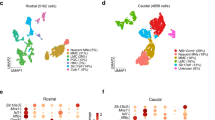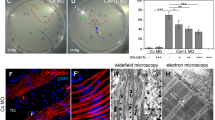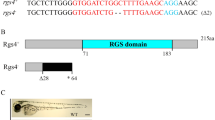Abstract
En route to their target, pioneering motor growth cones repeatedly encounter choice points at which they make pathway decisions. In the zebrafish mutant unplugged, two of the three segmental motor axons make incorrect decisions at a somitic choice point. Using positional cloning, we show here that unplugged encodes a homolog of muscle-specific kinase (MuSK) and that, unlike mammalian MuSK, unplugged has only a limited role in neuromuscular synaptogenesis. We demonstrate that unplugged is transiently expressed in cells adjacent to the choice point and that unplugged signaling before the arrival of growth cones induces changes in the extracellular environment. In addition, we find that the unplugged locus generates three different transcripts. The splice variant 1 (SV1) isoform lacks the extracellular modules essential for agrin responsiveness, and signaling through this isoform mediates axonal pathfinding, independent of the MuSK downstream component rapsyn. Our results demonstrate a new role for MuSK homologs in axonal pathway selection.
This is a preview of subscription content, access via your institution
Access options
Subscribe to this journal
Receive 12 print issues and online access
$209.00 per year
only $17.42 per issue
Buy this article
- Purchase on Springer Link
- Instant access to full article PDF
Prices may be subject to local taxes which are calculated during checkout







Similar content being viewed by others
References
Kaprielian, Z., Runko, E. & Imondi, R. Axon guidance at the midline choice point. Dev. Dyn. 221, 154–181 (2001).
Giger, R.J. & Kolodkin, A.L. Silencing the siren: guidance cue hierarchies at the CNS midline. Cell 105, 1–4 (2001).
Shirasaki, R. & Pfaff, S.L. Transcriptional codes and the control of neuronal identity. Annu. Rev. Neurosci. 25, 251–281 (2002).
Landmesser, L.T. The acquisition of motoneuron subtype identity and motor circuit formation. Int. J. Dev. Neurosci. 19, 175–182 (2001).
Lance-Jones, C. & Landmesser, L. Pathway selection by chick lumbosacral motoneurons during normal development. Proc. R. Soc. Lond. B Biol. Sci. 214, 1–18 (1981).
Tosney, K.W. & Landmesser, L.T. Pattern and specificity of axonal outgrowth following varying degrees of chick limb bud ablation. J. Neurosci. 4, 2518–2527 (1984).
Ferns, M.J. & Hollyday, M. Motor innervation of dorsoventrally reversed wings in chick/quail chimeric embryos. J. Neurosci. 13, 2463–2476 (1993).
Helmbacher, F., Schneider-Maunoury, S., Topilko, P., Tiret, L. & Charnay, P. Targeting of the EphA4 tyrosine kinase receptor affects dorsal/ventral pathfinding of limb motor axons. Development 127, 3313–3324 (2000).
Kania, A. & Jessell, T.M. Topographic motor projections in the limb imposed by LIM homeodomain protein regulation of ephrin-A:EphA interactions. Neuron 38, 581–596 (2003).
Beattie, C.E. Control of motor axon guidance in the zebrafish embryo. Brain Res. Bull. 53, 489–500 (2000).
Bernhardt, R.R., Goerlinger, S., Roos, M. & Schachner, M. Anterior-posterior subdivision of the somite in embryonic zebrafish: implications for motor axon guidance. Dev. Dyn. 213, 334–347 (1998).
Eisen, J.S., Myers, P.Z. & Westerfield, M. Pathway selection by growth-cones of identified motoneurons in live zebra fish embryos. Nature 320, 269–271 (1986).
Felsenfeld, A.L., Curry, M. & Kimmel, C.B. The fub-1 mutation blocks initial myofibril formation in zebrafish muscle pioneer cells. Dev. Biol. 148, 23–30 (1991).
Melançon, E., Liu, D.W.C., Westerfield, M. & Eisen, J.S. Pathfinding by identified zebrafish motorneurons in the absence of muscle pioneers. J. Neurosci. 17, 7796–7804 (1997).
Zhang, J. & Granato, M. The zebrafish unplugged gene controls motor axon pathway selection. Development 127, 2099–2111 (2000).
Zeller, J. & Granato, M. The zebrafish diwanka gene controls an early step of motor growth cone migration. Development 126, 3461–3472 (1999).
Devoto, S.H., Melancon, E., Eisen, J.S. & Westerfield, M. Identification of separate slow and fast muscle precursor cells in vivo, prior to somite formation. Development 122, 3371–3380 (1996).
Forrester, W.C. The Ror receptor tyrosine kinase family. Cell Mol. Life Sci. 59, 83–96 (2002).
Burden, S.J. Building the vertebrate neuromuscular synapse. J. Neurobiol. 53, 501–511 (2002).
Sanes, J.R. & Lichtman, J.W. Induction, assembly, maturation and maintenance of a postsynaptic apparatus. Nat. Rev. Neurosci. 2, 791–805 (2001).
Zhang, J., Malayaman, S., Davis, C. & Granato, M. A dual role for the zebrafish unplugged gene in motor axon pathfinding and pharyngeal development. Dev. Biol. 240, 560–573. (2001).
Gautam, M. et al. Defective neuromuscular synaptogenesis in agrin-deficient mutant mice. Cell 85, 525–535 (1996).
Gautam, M. et al. Failure of postsynaptic specialization to develop at neuromuscular junctions of rapsyn-deficient mice. Nature 377, 232–236 (1995).
DeChiara, T.M. et al. The receptor tyrosine kinase MuSK is required for neuromuscular junction formation in vivo. Cell 85, 501–512 (1996).
Coers, C. Structure and organization of the myoneural junction. Int. Rev. Cytol. 22, 239–267 (1967).
Westerfield, M., McMurray, J.V. & Eisen, J.S. Identified motoneurons and their innervation of axial muscles in the zebrafish. J. Neurosci. 6, 2267–2277 (1986).
Ono, F., Shcherbatko, A., Higashijima, S., Mandel, G. & Brehm, P. The zebrafish motility mutant twitch once reveals new roles for rapsyn in synaptic function. J. Neurosci. 22, 6491–6498 (2002).
Draper, B.W., Morcos, P.A. & Kimmel, C.B. Inhibition of zebrafish fgf8 pre-mRNA splicing with morpholino oligos: a quantifiable method for gene knockdown. Genesis 30, 154–156 (2001).
Nasevicius, A. & Ekker, S.C. Effective targeted gene 'knockdown' in zebrafish. Nat. Genet. 26, 216–220 (2000).
Du, S.J., Gao, J. & Anyangwe, V. Muscle-specific expression of myogenin in zebrafish embryos is controlled by multiple regulatory elements in the promoter. Comp. Biochem. Physiol. B Biochem. Mol. Biol. 134, 123–134 (2003).
Chung, K.Y., Taylor, J.S., Shum, D.K. & Chan, S.O. Axon routing at the optic chiasm after enzymatic removal of chondroitin sulfate in mouse embryos. Development 127, 2673–2683 (2000).
Walz, A., Anderson, R.B., Irie, A., Chien, C.B. & Holt, C.E. Chondroitin sulfate disrupts axon pathfinding in the optic tract and alters growth cone dynamics. J. Neurobiol. 53, 330–342 (2002).
Karlstrom, R.O., Talbot, W.S. & Schier, A.F. Comparative synteny cloning of zebrafish you-too: mutations in the Hedgehog target gli2 affect ventral forebrain patterning. Genes Dev. 13, 388–393 (1999).
Du, S.J. & Dienhart, M. Gli2 mediation of hedgehog signals in slow muscle induction in zebrafish. Differentiation 67, 84–91 (2001).
Zeller, J. et al. Migration of zebrafish spinal motor nerves into the periphery requires multiple myotome-derived cues. Dev. Biol. 252, 241–256 (2002).
Hwang, H.Y., Olson, S.K., Esko, J.D. & Horvitz, H.R. Caenorhabditis elegans early embryogenesis and vulval morphogenesis require chondroitin biosynthesis. Nature 423, 439–443 (2003).
Kitagawa, H., Uyama, T. & Sugahara, K. Molecular cloning and expression of a human chondroitin synthase. J. Biol. Chem. 276, 38721–38726 (2001).
Landgraf, M., Baylies, M. & Bate, M. Muscle founder cells regulate defasciculation and targeting of motor axons in the Drosophila embryo. Curr. Biol. 9, 589–592 (1999).
Hesser, B.A., Sander, A. & Witzemann, V. Identification and characterization of a novel splice variant of MuSK. FEBS Lett. 442, 133–137 (1999).
Zhou, H., Glass, D.J., Yancopoulos, G.D. & Sanes, J.R. Distinct domains of MuSK mediate its abilities to induce and to associate with postsynaptic specializations. J. Cell Biol. 146, 1133–1146 (1999).
Hikasa, H., Shibata, M., Hiratani, I. & Taira, M. The Xenopus receptor tyrosine kinase Xror2 modulates morphogenetic movements of the axial mesoderm and neuroectoderm via Wnt signaling. Development 129, 5227–5239 (2002).
Oishi, I. et al. The receptor tyrosine kinase Ror2 is involved in non-canonical Wnt5a/JNK signalling pathway. Genes Cells 8, 645–654 (2003).
Moeller, C., Swindell, E.C., Kispert, A. & Eichele, G. Carboxypeptidase Z (CPZ) modulates Wnt signaling and regulates the development of skeletal elements in the chicken. Development 130, 5103–5111 (2003).
Yoshikawa, S., McKinnon, R.D., Kokel, M. & Thomas, J.B. Wnt-mediated axon guidance via the Drosophila Derailed receptor. Nature 422, 583–588 (2003).
Lyuksyutova, A.I. et al. Anterior-posterior guidance of commissural axons by Wnt-frizzled signaling. Science 302, 1984–1988 (2003).
Mullins, M.C., Hammerschmidt, M., Haffter, P. & Nüsslein-Volhard, C. Large-scale mutagenesis in the zebrafish: in search of genes controlling development in a vertebrate. Curr. Biol. 4, 189–202 (1994).
Odenthal, J. & Nusslein-Volhard, C. Forkhead domain genes in zebrafish. Dev. Genes Evol. 208, 245–258 (1998).
Downes, G.B., Waterbury, J.A. & Granato, M. Rapid in vivo labeling of identified zebrafish neurons. Genesis 34, 196–202 (2002).
Acknowledgements
We thank A. Coulson and the Sanger Center for sequencing BAC and PAC clones; P. Brehm for twitch once mutants; and M. Mullins, G. Bashaw, V. Schneider, G. Downes, H. Burgess, M. Gyda and L. Jing for critical comments on the manuscript. This work was supported by a Fellowship from the Myasthenia Gravis Foundation to J.L.L. and grants from the National Institutes of Health to M.G.
Author information
Authors and Affiliations
Corresponding author
Ethics declarations
Competing interests
The authors declare no competing financial interests.
Supplementary information
Supplementary Fig. 1
Sequence alignment between unplugged and MuSK family members. (PDF 77 kb)
Supplementary Fig. 2
unplugged dependent tyrosine phosphorylation on adaxial cells. Confocal images of cross section from 20 somite stage wild-type (a-c, g-i) and unplugged embryos (d-f, j-l) stained with α-pTyr and with the adaxial specific F59 antibody. (a-f) In somites 18-20, phosphotyrosine staining is detectable through out the embryo, but appears concentrated on premigratory adaxial cells. Note the intense phosphotyrosine staining on membranes between adaxial cells (arrowheads in inset) (g-l) In somites 16/15, adaxial cells are about to migrate. In unplugged mutants, phosphotyrosine staining on membranes between adaxial cells is severely reduced (k, l; 15 sections from 5 genotyped -/- embryos). No reduction is detectable on lateral membranes shared with notochord (medial) or fast muscle (lateral), but there seems to be increased phosphotyrosine staining on fast muscle (lateral). (JPG 183 kb)
Supplementary Video 1
Wild-type larvae at 5 dpf. (MOV 207 kb)
Supplementary Video 2
unplugged larvae at 5 dpf. (MOV 158 kb)
Rights and permissions
About this article
Cite this article
Zhang, J., Lefebvre, J., Zhao, S. et al. Zebrafish unplugged reveals a role for muscle-specific kinase homologs in axonal pathway choice. Nat Neurosci 7, 1303–1309 (2004). https://doi.org/10.1038/nn1350
Received:
Accepted:
Published:
Issue Date:
DOI: https://doi.org/10.1038/nn1350



